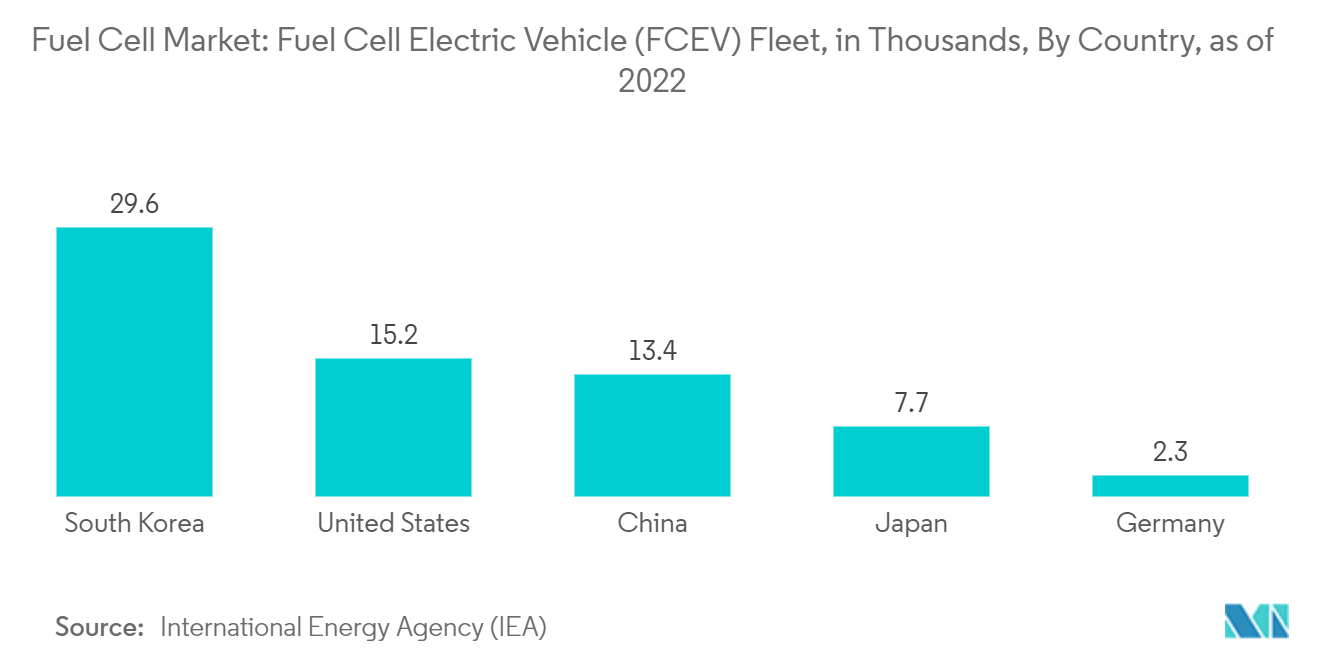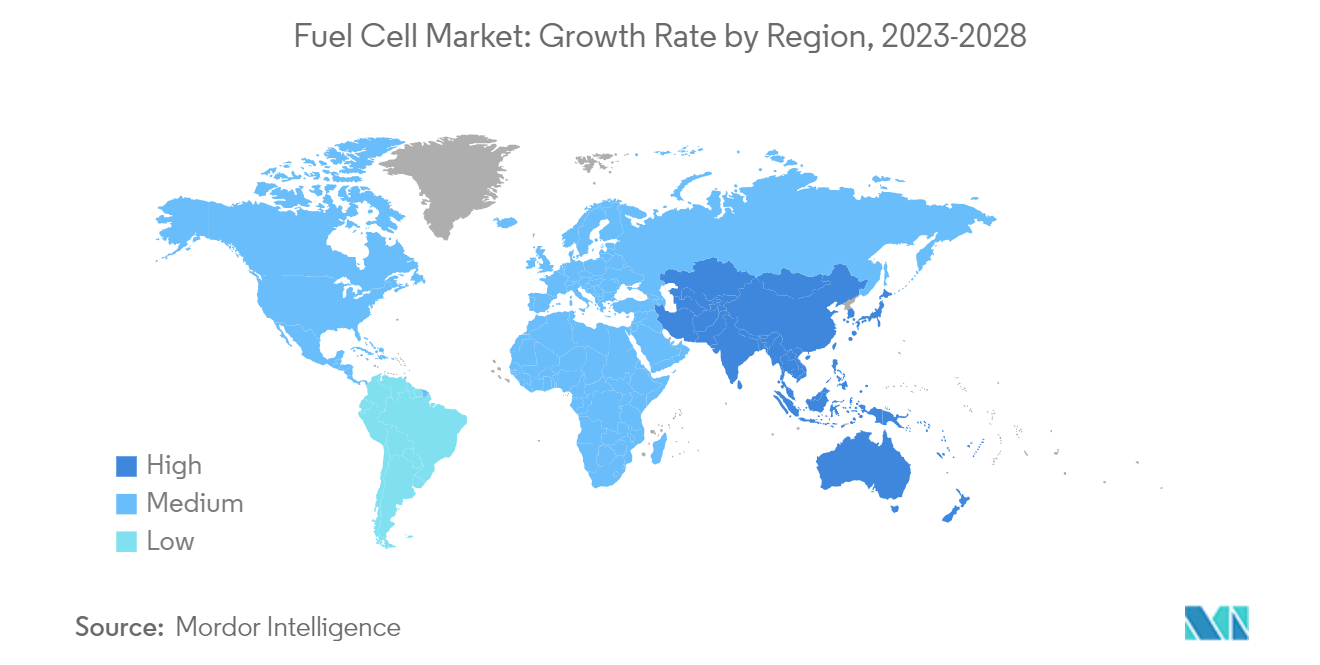Market Trends of Fuel Cell Industry
Vehicular Application to Dominate the Market
- The fuel cell-based automotive industry has become more lucrative in recent years due to the higher performance, reduced refueling time, and long range offered by the systems. The exhaust in terms of water, a decline in the proportion of emissions, and superior power and torque output play a significant role in terms of the adoption of fuel cell technologies for automobiles.
- On a traditional vehicle, the fuel cell technology provides a driving range of over 300 miles. It reduces the weight of carrying heavy batteries compared to battery electric vehicles, thereby boosting the market's growth over the forecast period.
- Furthermore, government regulations for reducing environmental pollution encourage the adoption of fuel cells in the automotive sector. The countries are focusing on R&D and investing in fuel cell technology to improve their public transportation while reducing harmful emissions. For instance, the South Korean government plans to replace around 26,000 CNG buses with fuel-cell buses by 2030.
- Also, material-handling vehicles, such as forklifts, trucks, etc., are expected to witness significant growth over the forecast period due to their increased usage in the logistics and construction sectors. Fuel cells are used as replacements for internal combustion engines in light-duty vehicles and warehouse forklifts, primarily to improve efficiency and reduce oil consumption.
- Furthermore, in methanol fuel cell trucks, the fuel is stored in refillable onboard tanks to reduce the refueling time, thereby providing feasibility for long routes. The major automobile manufacturers are developing Class 8 vehicles that operate on fuel cell technology.
- In the Asia-Pacific region, the adoption of fuel-cell electric vehicles is expected to be driven by strong incentives and government policies. This is expected to boost consumer acceptance and increase private investments by companies seeking to establish global fuel cell network refueling stations.
- Over the next five years, leading original equipment manufacturers (OEMs) are expected to launch approximately 20 fuel cell vehicle models in the Asia-Pacific market. Asian OEMs, with a first-mover advantage, are expected to dominate the market during the forecast period. For instance, the unit sales of Toyota fuel cell electric vehicles are estimated at 165,000 and those of Hyundai fuel cell electric vehicles at 148,000 by 2030.
- Japan is at the forefront in terms of the adoption of alternative fuel technologies. The Japanese government and the local original equipment manufacturers (OEMs) focus on standardizing electrified powertrains globally. Meanwhile, the Japanese government also encouraged hydrogen fuel technology for large-scale deployments and transport applications. The country has set a target of having 200,000 FCVs on the road by 2025.
- North America is the second-largest market for vehicular fuel cells, mainly dominated by the United States. Stringent emission norms, the presence of technology producers, incentives in the form of tax credits, etc., drive the market growth for fuel cell systems in the vehicular segment of the country. According to International Energy Agency (IEA), as of 2022, 15.2 thousand of total fuel cell vehicle was in circulation.
- The presence of some of the most prominent automotive manufacturers and original equipment manufacturers in the country is another major factor expected to propel the large-scale adoption of fuel cell commercial vehicles in the United States. Hyundai plans to build a production capacity of nearly 500k fuel cell systems for commercial and passenger vehicles by 2030 at an estimated cost of USD 6.4 billion.
- Hence, vehicular applications are expected to dominate the market due to increasing technological innovation and rising private player involvement.

Asia-Pacific to Dominate the Market
- Asia-Pacific is one of the most promising regional markets for fuel cells on account of the favorable government policies for clean energy usage in countries such as China, Japan, India, and South Korea.
- China is the country with one of the highest potentials for fuel cells due to the following reasons: The hydrogen fuel cell industry in the country has been gaining traction on the back of favorable national and provincial government subsidies and incentive programs from local authorities, mainly to encourage the uptake of hydrogen vehicles to cut pollution.
- Along with the potentially large market, China also has numerous domestic enterprises that manufacture fuel cells. Hence, the demand and the domestic supply are present in the country, further bolstering the growth of the market.
- China has great potential in the fuel cell market as the government is increasingly focusing on ways to utilize clean energy technology in order to switch to a low-carbon economy.
- China has also witnessed a rise in its hyper-scale platforms, owing to which providing data center services for Chinese hyper-scale platforms has become necessary. China has 50 internet users per 100 people, indicating scope for a lot of development and expansion in the connectivity ecosystem. The data centers can become major consumers of fuel cell technology in the country.
- In 2022, Elcogen incorporated solid oxide fuel cell (SOFC) and stack technology into the Convion C60 power unit to generate heat and electricity with high efficiency levels. The project provides a template for future projects of this kind, also at scale, which are expected to enable companies to generate both heat and electricity at high efficiency levels, all while reducing carbon emissions.
- In India, the government has been supporting research, development, and demonstration projects on various aspects of hydrogen, including its production, storage, and use as a fuel for power generation, which is likely to fuel an opportunity for the fuel cell market in the country.
- Further, in January 2023, the government of India announced the National Green Hydrogen Mission with initial funding of USD 2.4 billion, including an outlay of USD 2.1 billion for the SIGHT program, USD 700 million for pilot projects, USD 50 million for R&D, and USD 40 million for other mission components.
- Further, the country's green hydrogen production capacity is likely to reach at least 5 MMT per annum, with an associated renewable energy capacity addition of about N125 GW. The targets by 2030 are likely to bring in over INR 8 lakh crore of investments, and nearly 50 MMT of CO2 emissions are expected to be averted by 2030.
- Japan imports foreign resources to satisfy over 90% of its energy consumption needs. As a result, the heavy reliance on fossil fuels places Japan in fifth place globally in carbon intensity. However, Japan has been undergoing a significant transition in recent years, shifting away from fossil fuels and renewable energy sources. The country has strived to reform its energy policy and systems by focusing on renewable energy and clean hydrogen.
- Japan implemented one of the most successful fuel cell commercialization programs, the Ene-farm program, in 2015. The program led to the deployment of over 120,000 residential fuel cell systems. Japan remains, by far, the leader in developing and deploying small-scale fuel cell systems through the Ene-farm program, which provides subsidies for purchasing residential fuel cell systems for the domestic CHP.
- Therefore, factors such as supportive government policies and efforts to incorporate fuel cell technology in transportation and other applications are expected to drive the region's fuel cell market during the forecast period.


